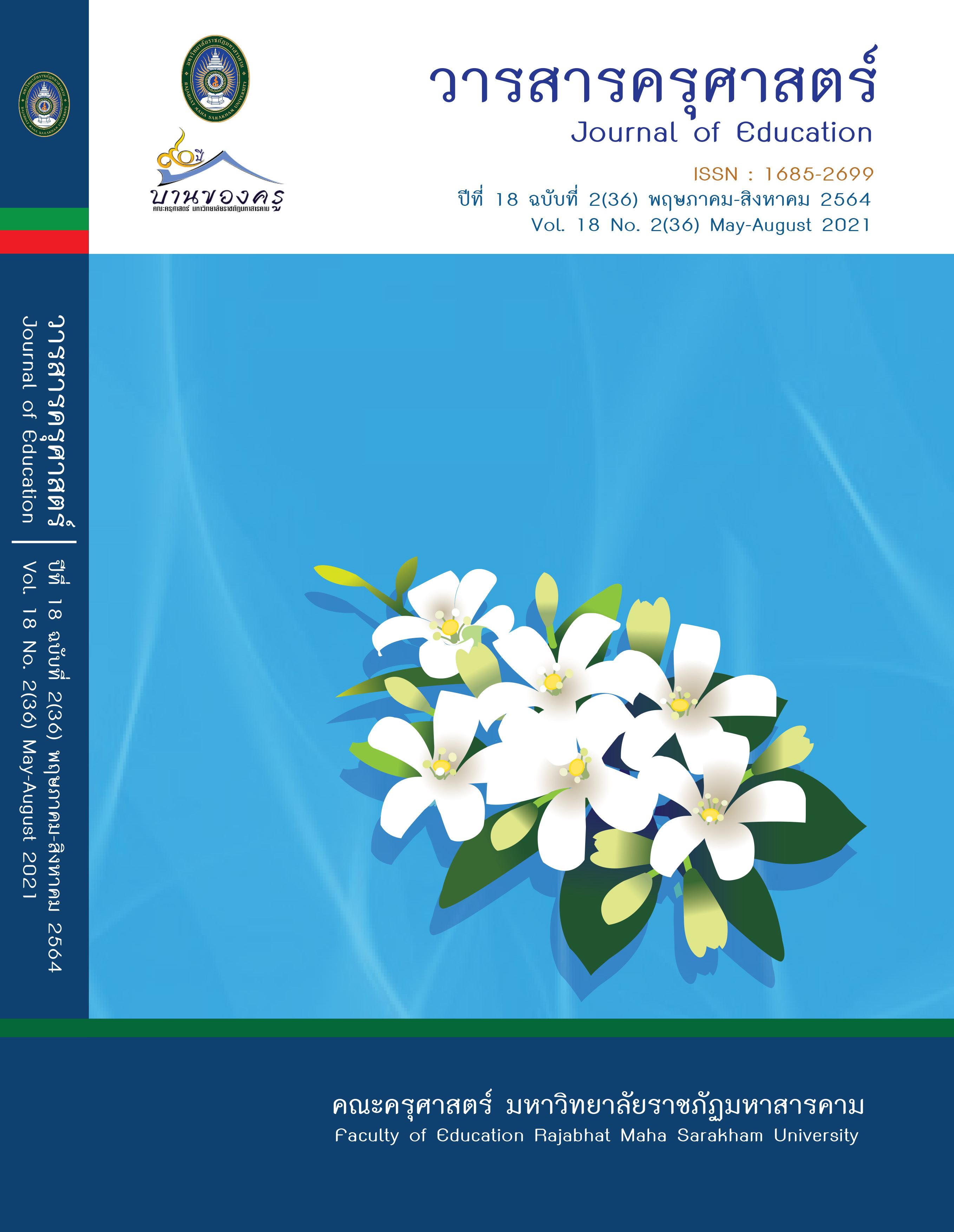The Development of Learning Activities Using the KWDL Technique for promoting the Analytical thinking Of Mathayomsuksa 2 students of History
Main Article Content
Abstract
The purposes of this research were to; 1) develop learning activities with KWDL technique in order to promote the efficiency of critical thinking ability of Mathayomsuksa 2 students in history according to the criteria of 80/80, 2) compare students' critical thinking ability before and after learning with KWDL learning activities and 3) compare students' learning achievement before and after using KWDL technique. The samples were 36 Mathayom Suksa 2/2 students, Chiang Yuen Pittayakom School, Mahasarakham Province, enrolling in the second semester of academic year 2021, examined by stratified random sampling. The research instruments were 1) 10 the learning management plan using KWDL technique within 10 hours. Mean was 4.88 to 4.96, 2) 20 items Analytical Thinking Ability of four multiple choices test based on 8 situations. IOC value was 0.60 to 0.80; discriminative power was 0.22 to 0.44, and reliability was 0.60. and 3) 25 items achievement multiple-choices test. IOC values ranging was 0.80 to 1.00, discrimination power was 0.20 to 0.75, difficulty was 0.42 to 0.75, and reliability in the whole was 0.84. The statistics were analyzed by percentage, mean, standard deviation, and t-test. The findings of this research found that 1) Learning activities through using KWDL techniques of Mathayomsuksa 2 students had the efficiency of 82.18/81.80, 2) the Mathayomsuksa 2 students’ analytical thinking ability after being taught using KWDL technique was higher than before statistically at the .05 level of significance, and 3) the students’ learning achievement was higher than before statistically at the .05 level of significance.
Article Details
ข้อกำหนดเบื้องต้นที่ผู้นิพนธ์(ผู้ส่งบทความ) ควรทราบ
1. ผู้นิพนธ์ที่ประสงค์จะลงตีพิมพ์บทความกับวารสาร ตั้งแต่เดือนมกราคม 2563 เป็นต้นไป ให้ใช้รูปแบบใหม่ (Template 2563) โดยสามารถดูตัวอย่างได้ที่เมนู GUIDELINES
2. จะตีพิมพ์และเผยแพร่ได้ ต้องผ่านการประเมินจากผู้ทรงคุณวุฒิ (Peer Review)
3. การประเมินบทความโดยผู้ทรงคุณวุฒิ (Peer Review) เป็นแบบ Double Blind
4. การอ้างอิงบทความใช้หลักเกณฑ์ APA (American Psychological Association) คลิก
5. บทความถูกปฏิเสธการตีพิมพ์ ไม่ผ่านการประเมิน ผู้นิพนธ์ขอยกเลิกเองหรือชำระเงินก่อนได้รับการอนุมัติ ทางวารสารไม่มีนโยบายการคืนเงิน
References
กระทรวงศึกษาธิการ. (2551). หลักสูตรแกนกลางการศึกษาขั้นพื้นฐาน พุทธศักราช 2551 (ฉบับปรับปรุง). การเกษตรแห่งประเทศไทย.
เกรียงศักดิ์ เจริญวงศ์. (2546). การคิดวิเคราะห์. มหาวิทยาลัยธรรมศาสตร์.
เจนจิรา เครือทิวา. (2559). การศึกษาความสามารถในการคิดวิเคราะห์และผลสัมฤทธิ์ทางการเรียน เรื่อง แสงของนักเรียนชั้นมัธยมศึกษาปีที่ 2 ด้วยการจัดการเรียนรู้แบบสืบเสาะหาความรู้ (5E) ร่วมกับเทคนิคKWDL. [วิทยานิพนธ์ปริญญามหาบัณฑิต ไม่ได้ตีพิมพ์]. มหาวิทยาลัยบูรพา.
เฉลิม นิติเขตต์ปรีชา. (2545). เทคนิควิธีการสอนประวัติศาสตร์. เอส อาร์ พริ้นติ้งจำกัด.
จรรยา หารพรม. (2560). ได้การพัฒนาผลการเรียนรู้คณิตศาสตร์และพฤติกรรมการทางานกุล่มโดยการจัดการเรียนรู้แบบSTAD ร่วมกับ KWDL ของนักเรียนชั้นประถมศึกษาปีที่ 3. [วิทยานิพนธ์ปริญญามหาบัณฑิตไม่ได้ตีพิมพ์]. มหาวิทยาลัยศิลปากร.
เบญจลักษณ์ น้ำฟ้า. (2551). ประวัติศาสตร์ไทย. สหมิตรพริ้นติ้งแอนด์พับลิสซิง.
ปาริสา ไชยกุล. (2563). ได้ทำการศึกษาผลการจัดการเรียนรู้ เรื่อง การบวก ลบ คูณ หารระคน โดยใช้สมองเป็นฐาน(BBL) ร่วมกับเทคนิค KWDL ที่มีต่อความสามารถในการแก้ปัญหาทางคณิตศาสตร์ และความสามารถในการคิดวิเคราะห์ ของนักเรียนชั้นประถมศึกษาปีที่ 3. วารสารวิชาการมหาวิทยาลัยราชภัฏศรีสะเกษ, 14(3), 120-135.
พนัชกร หอมเฮ้า, มาลี ศรีพรม และประยูร บุญใช้. (2556). การพัฒนากิจกรรมการเรียนรู้คณิตศาสตร์ เรื่อง อัตราส่วน ร้อยละ โดยใช้การเรียนรู้แบบร่วมมือ รูปแบบ STAD ร่วมกับเทคนิค KWDL สำหรับนักเรียนชั้นมัธยมศึกษาปีที่ 2.วารสารวิชาการหลักสูตรและการสอน, 5(14), 151-160.
วรทัศน์ อินทรัคคัมพร. (2548). ทฤษฎีการเปลี่ยนแปลงทางสังคม. โรงพิมพ์ชวนชมการพิมพ์.
สิทธิพล อาจอินทร์. (2554). การพัฒนารูปแบบการจัดการเรียนรู้ที่เน้นการคิดวิเคราะห์ (พิมพ์ครั้งที่ 4). มหาวิทยาลัยศิลปากร.
สุภาพร นามไธสง และวรรณชิต ยลวิลาศ. (2561). การจัดกิจกรรมการเรียนรู้ด้วยเทคนิค KWDL เรื่อง การประยุกต์ เกี่ยวกับอัตราส่วน และร้อยละ ที่มีผลต่อทักษะการแก้ปัญหาทางการเรียนคณิตศาสตร์ สำหรับนักเรียนชั้นมัธยมศึกษาปีที่ 2. [วิทยานิพนธ์ปริญญามหาบัณฑิต ไม่ได้ตีพิมพ์]. มหาวิทยาลัยกาฬสินธุ์.
Shaw; & ; et al. (1997). Problem Solving and Mathematical Communication by K-W-D-L (Know-Want-Do-Learned) technique. http.//vnweb.hwwilsonweb.com/hww/results/results_single_ftPES.


